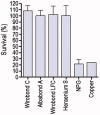In vitro element release and biological aspects of base-metal alloys for metal-ceramic applications
- PMID: 28642904
- PMCID: PMC5433186
- DOI: 10.3109/23337931.2015.1069714
In vitro element release and biological aspects of base-metal alloys for metal-ceramic applications
Abstract
Objective: The aims of this study were to investigate the release of element from, and the biological response in vitro to, cobalt-chromium alloys and other base-metal alloys used for the fabrication of metal-ceramic restorations. Material and methods: Eighteen different alloys were investigated. Nine cobalt-chromium alloys, three nickel-chromium alloys, two cobalt-chromium-iron alloys, one palladium-silver alloy, one high-noble gold alloy, titanium grade II and one type III copper-aluminium alloy. Pure copper served as positive control. The specimens were prepared according to the ISO standards for biological and corrosion testing. Passive leaching of elements was measured by using Inductively Coupled Plasma - Mass Spectrometry (ICP-MS) after incubation in cell culture media, MEM, for 3 days. Corrosion testing was carried out in 0.9% sodium chloride (NaCl) and 1% lactic acid for 7 days, and the element release was measured by Inductively Coupled Plasma - Optical Emission Spectroscopy (ICP-OES). The biological response from the extract solutions was measured though MTT cytotoxicity testing and the Hen's egg test-chorio-allantoic membrane (HET-CAM) technique for irritationt. Results: The corrosion test showed similar element release from base-metal alloys compared to noble alloys such as gold. Apart from the high-copper alloy, all alloys expressed low element release in the immersion test, no cytotoxic effect in the MTT test, and were rated non-irritant in the HET-CAM test. Conclusions: Minimal biological response was observed for all the alloys tested, with the exception of the high-copper alloy.
Keywords: Base metal; cell-culture; cobalt–chromium; corrosion; irritation; leaching; metal-ceramic.
Conflict of interest statement
The authors report no conflicts of interest. The authors alone are responsible for the content and writing of this article.
Figures


Similar articles
-
Static immersion and irritation tests of dental metal-ceramic alloys.Eur J Oral Sci. 2005 Feb;113(1):83-9. doi: 10.1111/j.1600-0722.2005.00187.x. Eur J Oral Sci. 2005. PMID: 15693834
-
Inductively coupled plasma-mass spectroscopy measurements of elemental release from 2 high-palladium dental casting alloys into a corrosion testing medium.J Prosthet Dent. 2002 Jan;87(1):80-5. doi: 10.1067/mpr.2002.121238. J Prosthet Dent. 2002. PMID: 11807488
-
Evaluation of effect of galvanic corrosion between nickel-chromium metal and titanium on ion release and cell toxicity.J Adv Prosthodont. 2015 Apr;7(2):172-7. doi: 10.4047/jap.2015.7.2.172. Epub 2015 Apr 23. J Adv Prosthodont. 2015. PMID: 25932317 Free PMC article.
-
Potentiodynamic polarization study of the in vitro corrosion behavior of 3 high-palladium alloys and a gold-palladium alloy in 5 media.J Prosthet Dent. 2002 Jan;87(1):86-93. doi: 10.1067/mpr.2002.121239. J Prosthet Dent. 2002. PMID: 11807489
-
Corrosion and biocompatibility testing of palladium alloy castings.Dent Mater. 2001 Jan;17(1):7-13. doi: 10.1016/s0109-5641(00)00033-6. Dent Mater. 2001. PMID: 11124408
Cited by
-
Cytotoxicity of Commercially Pure Titanium (cpTi), Silver-Palladium (Ag-Pd), and Nickel-Chromium (Ni-Cr) Alloys Commonly Used in the Fabrication of Dental Prosthetic Restorations.Cureus. 2022 Nov 19;14(11):e31679. doi: 10.7759/cureus.31679. eCollection 2022 Nov. Cureus. 2022. PMID: 36561578 Free PMC article.
-
Corrosive Studies of a Prosthetic Ni-Cr Alloy Coated with Ti(C,N) Type Layers.Materials (Basel). 2022 Mar 27;15(7):2471. doi: 10.3390/ma15072471. Materials (Basel). 2022. PMID: 35407804 Free PMC article.
-
Cobalt-chromium alloys in fixed prosthodontics in Sweden.Acta Biomater Odontol Scand. 2017 Aug 11;3(1):53-62. doi: 10.1080/23337931.2017.1360776. eCollection 2017. Acta Biomater Odontol Scand. 2017. PMID: 29242813 Free PMC article.
References
-
- Polyzois GL, Dahl JE, Hensten-Pettersen A. Biological testing of dental materials: development of national and international standards. J Biomater Appl. 1995;9:255–362 - PubMed
-
- Stenberg T. Release of cobalt from cobalt chromium alloy restorations in the oral cavity of man. Scand J Dent Res. 1982;90:472–479 - PubMed
-
- Van Noort R. Casting alloys for metallic restorations. In: Van Noort R. Introduction to Dental Materials. Edinburgh, New York. Mosby Elsevier; 2007. p 227–236
-
- Wataha JC. Biocompatibility of dental casting alloys: a review. J Prosthet Dent. 2000;83:223–234 - PubMed
LinkOut - more resources
Full Text Sources
Other Literature Sources
